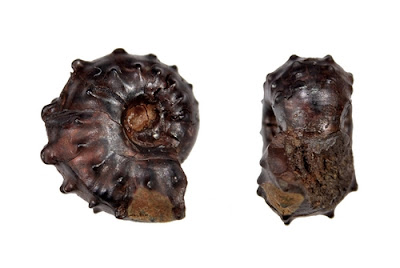The Olcostephaninae, as recognised by Wright et al. (1996), are known from the Valanginian and Hauterivian epochs of the Early Cretaceous, disappearing from the fossil record some time during the earlier part of the latter. The Valanginian ran from about 140 to 133 million years ago; the Hauterivian lasted for about three and a half million years after that. A brief reminder here: the Cretaceous lasted for a bloody long time, with more time separating the beginning and end of the Cretaceous than separates the end of the Cretaceous and today. One genus described from Pakistan, Provalanginites, has been supposed to come from the latest Jurassic but, as this is at least five million years earlier than any known olcostephanine anywhere else, its age is regarded as questionable. Olcostephanines can be very abundant in formations of the right age. A mass occurrence in the latest Valanginian of northwestern Europe has long been recognised as a geological marker, dubbed the 'Astierien Schichten' (Astieria being a synonym of Olcostephanus; Lukeneder 2004).
Olcostephanines are small to moderate-sized ammonites. Lukeneder (2004) refers to macroconches* of Olcostephanus guebhardi up to about ten centimetres in diameter. The olcostephanines pictured in Wright et al. (1996) seem to indicate an average size smaller than this and the group also includes a number of dwarf genera that look to only be a bit over one centimetre in diameter. The shell of olcostephanines is usually characterised by a pattern of transverse ribs coalescing in bundles to meet tubercles on the inner margin of the whorl. One dwarf genus, Saynoceras, has a stronger ornamentation of two rows of tubercles near the midline and outer margins of the whorls.
*A common pattern in ammonoids is the co-occurrence within a formation of distinct forms, termed 'macroconches' and 'microconches', that are broadly similar except in size and the configuration of the aperture (generally simple in macroconches but with protruding lappets in microconches). The most popular interpretation of this phenomenon is that the forms represent sexual dimorphism. Obviously which sex is which can't be known at this time though comparison with living cephalopods suggests that the macroconches may be female.
Olcostephanines are very similar in external appearance to the earlier subfamily Spiticeratinae (known from the very earliest part of the Cretaceous) and are likely to be descended from among that group. Though the Olcostephaninae themselves as currently recognised disappeared during the Hauterivian epoch, this may not have been the actual end of the olcostephanine lineage. The slightly later Holcodiscidae are very similar to the olcostephanines and some have questioned whether they even warrant separation. There is also a strong similarity between early members of the superfamily Desmoceratoidea and species of Olcostephanus (Wright et al. 1996). If this similarity also indicates ancestry, then the family line of the olcostephanines would continue right until the final extinction of the ammonites at the end of the Cretaceous.
REFERENCES
Lukeneder, A. 2004. The Olcostephanus level: an Upper Valanginian ammonoid mass-occurrence (Lower Cretaceous, Northern Calcareous Alps, Austria). Acta Geologica Polonica 54 (1): 23–33.
Wright, C. W., J. H. Calloman & M. K. Howarth. 1996. Treatise on Invertebrate Paleontology pt L. Mollusca 4, revised vol. 4. Cretaceous Ammonoidea. The Geological Society of America, Inc.: Boulder (Colorado), and The University of Kansas: Lawrence (Kansas).
source http://coo.fieldofscience.com/2020/12/the-age-of-olcostephaninae.html



No comments:
Post a Comment